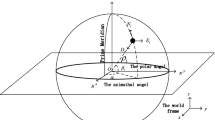Abstract
This paper presents a distributed target-centric formation control strategy for multiple unmanned aerial vehicles (UAVs) in the presence of target motion uncertainty. The formation is maintained around a target using a combination of a consensus protocol and a sliding mode control law. Consensus helps in distributing the target information which is available only to a subset of vehicles. Sliding mode control compensates for the uncertainty in the target information. Hence, collectively the combined strategy enforces each of the vehicles to maintain its respective position in the formation. We show that if at least one vehicle in a group has target information with some uncertainty and the corresponding communication graph is connected, then a target-centric formation can be maintained. The performance of the proposed strategy is illustrated through simulations.
Similar content being viewed by others
References
Wei, G., Sen, S.: Adaption and learning in multi-agent systems. In: Lecture Notes in Computer Science, pp. 1042. Springer, Berlin (1995)
Beard, R.W., McLain, T.W., Nelson, D.B., Kingston, D., Johanson, D.: Decentralized cooperative aerial surveillance using fixed-wing miniature UAVs. In: IEEE Proceedings: special Issue on Multi-Robot Systems, vol. 94, no. 7, pp. 1306–1324 (2006)
Gil, A.E., Passino, K.M., Cruz, J.B.: Stable cooperative surveillance with information flow constraints. In: IEEE Transactions on Control Systems Technology, vol. 16, no. 5, pp. 856–868 (2008)
Beard, R.W., McLain, T.W.: Multiple uav cooperative search under collision avoidance and limited range communication constraints. In: Proc. 42nd IEEE Conf. Decision and Control, vol. 1, pp. 25–30 (2003)
Jennings, J.S., Whelan, G., Evans, W.F.: Cooperative search and rescue with a team of mobile robots. In: Proc. Conf. th Int Advanced Robotics ICAR ’97, pp. 193–200 (1997)
Casbeer, D.W., Beard, R.W., McLain, T.W., Li, S.-M., Mehra, R.K.: Forest fire monitoring with multiple small uavs. In: Proc. American Control Conf the 2005, pp. 3530–3535 (2005)
Sujit, P.B., Kingston, D., Beard, R.: Cooperative forest fire monitoring using multiple uavs. In: Proc. 46th IEEE Conf. Decision and Control, pp. 4875–4880 (2007)
Desai, J.P., Ostrowski, J., Kumar, V.: Controlling formations of multiple mobile robots. In: Proceeding of the IEEE International Conference on Robotics and Automation (1998)
Tanner, H., Pappas, G., Kumar, G.: Leader-to-formation stability. IEEE Trans. Robot. Autom 20(3), 443–455 (2004)
Consolini, L., Morbidi, F., Prattichizzo, D., Tosques, M.: Leader–follower formation control of nonholonomic mobile robots with input constraints. Automatica 44(5), 1343–1349 (2008)
Vidal, R., Shakernia, O., Sastry, S.: Formation control of nonholonomic mobile robots with omnidirectional visual servoing and motion segmentation. In: Proceedings IEEE International Conference on Robotics and Automation ICRA’03, vol. 1, pp. 584–589 (2003)
Shao, J., Xie, G., Yu, J., Wang, L.: Leader-following formation control of multiple mobile robots. In: Intelligent Control, 2005. Proceedings of the 2005 IEEE International Symposium on, Mediterrean Conference on Control and Automation, pp. 808–813 (2005)
Ren, W., Beard, R.W.: A decentralized scheme for spacecraft formation flying via the virtual structure approach. In: Proceeding of the IEEE American Control Conference, vol. 2, pp. 1746–1751 (2003)
Tan, K.-H., Lewis, M.A.: Virtual structures for high-precision cooperative mobile robotic control. In: Proceeding of the IEEE/RSJ International Conference on Intelligent Robots and Systems (1996)
Lewis, M., Tan, K.: High precision formation control of mobile robots using virtual structures. Auton. Robots 4(4), 387–403 (1997)
Lalish, E., Morgansen, K., Tsukamaki, T.: Formation tracking control using virtual structures and deconfliction. In: 45th IEEE Conference on Decision and Control, pp. 5699–5705 (2006)
Balch, T., Arkin, R.C.: Behavior-based formation control for multirobot teams. IEEE Trans. Robot. Autom. 14(6), 926–939 (1999)
Monteiro, S., Bicho, E.: A dynamical systems approach to behavior-based formation control. In: Proceedings IEEE International Conference on Robotics and Automation, ICRA’02, pp. 2606–2611 (2002)
Chen, Y.Q., Wang, Z.: Formation control: a review and a new consideration. In: Proceedings of IEEE/RSJ International Conference on Intelligent Robots and Systems (IROS 2005), pp. 3181–3186 (2005)
Kim, T.H., Sugie, T.: Cooperative control for target-capturing task based on a cyclic pursuit strategy. Automatica 43, 1426–1431 (2007)
Jadbabaie, A., Lin, J., Morse, A.S.: Correction to coordination of groups of mobile autonomous agents using nearest neighbor rule. IEEE Trans. Automat. Contr. 48(9), 1675–1675 (2003)
Ren, W., Beard, R.W.: Consensus seeking in multiagent systems under dynamically changing interaction topologies. 50(5), 655–661 (2005)
Olfati-Saber, R., Fax, J.A., Murray, R.M.: Consensus and cooperation in networked multi-agent systems. In: Proceedings of the IEEE, vol. 95, no. 1, pp. 215–233 (2007)
Ren, W.: Second-order consensus algorithm with extensions to switching topologies and reference models. In: Proceeding of the IEEE American Control Conference, pp. 1431–1436 (2007)
Kawakami, H., Namerikawa, T.: Cooperative target-capturing strategy for multi-vehicle systems with dynamic network topology. In: Proceeding of the IEEE American Control Confrence (2009)
Khalil, H.K.: Nonlinear Systems. Prentice Hall (2002)
Author information
Authors and Affiliations
Corresponding author
Rights and permissions
About this article
Cite this article
Kothari, M., Sharma, R., Postlethwaite, I. et al. Cooperative Target-capturing with Incomplete Target Information. J Intell Robot Syst 72, 373–384 (2013). https://doi.org/10.1007/s10846-012-9808-0
Received:
Accepted:
Published:
Issue Date:
DOI: https://doi.org/10.1007/s10846-012-9808-0



